
At any given moment, there are almost 2,000 thunderstorms occurring over the Earth. It is estimated that 100 lightning flashes occur each second somewhere on the planet, adding up to nearly 8 million lightning flashes per day.
Lightning occurs most frequently during thunderstorms, but has also been observed during volcanic eruptions, extremely intense forest fires, and surface nuclear detonations according to NOAA.
How lightning forms
NWS’s Lightning Science page explains lightning is a giant spark of electricity in the atmosphere or between the atmosphere and the ground.
In the initial stages of development, air acts as an insulator between the positive and negative charges in the cloud and between the cloud and the ground; however, when the differences in charges becomes too great, this insulating capacity of the air breaks down and there is a rapid discharge of electricity that we know as lightning. Below is a brief video by NWS...
Did you know…
- lightning often strikes the same place repeatedly, especially if it’s a tall, pointy, isolated object?! For example, the Empire State Building is hit nearly 100 times a year.
- the U.S. gets an estimated 25 million lightning flashes each year?!
- lightning can travel 60 miles or more, often extending up to 10 miles away from the cloud that formed it?! Generally, however, a bolt travels 10 miles or less.
- most cars are safe from lightning, but it is the metal roof and metal sides that protect you, NOT the rubber tires. Remember, convertibles, motorcycles, bicycles, open-shelled outdoor recreational vehicles and cars with fiberglass shells offer no protection from lightning.
Some tips to prepare your home for lightning include…
Install a Lightning Protection System
A lightning protection system does not prevent lightning from striking but does create a direct path for lightning to follow. Basically, a lightning protection system consists of air terminals (lightning rods) and associated fittings connected by heavy cables to grounding equipment. This provides a path for lightning current to travel safely to the ground.
Install surge protectors on or in home
Surge protection devices (SPDs) can be installed in the electrical panel to protect your entire home from electrical surges. Sometimes it may be necessary to install small individual SPDs in addition to the home unit for computers and television sets due to different ratings and voltage levels. If a home unit is too expensive, consider getting individual SPDs that plug into the wall for the refrigerator, microwave and garage door openers. Appliances that use two services (cable wire and electrical cord) may require combination SPDs for computers, TVs, and VCRs. (Better yet – consider getting an uninterrupted power supply [UPS] with surge protection and battery backup so you can shut down computers safely.)

Some basic lightning safety tips include…
Listen & watch – If you hear thunder, you’re close enough to be struck by lightning – take cover as quickly as possible. Be aware that lightning often strikes miles away from the rainfall or thunderstorm cloud.
Hairy sign – If you feel your hair stand on end and feel tingly (which means lightning is about to strike)… crouch down, get on the balls of your feet and bend forward putting hands on your knees (BE SMALL). And do NOT lie flat on ground since that makes you a bigger target!
Unplug it – Before thunderstorms, unplug appliances if possible – even ones on a surge protector and it’s best to move plugs away from outlets.
IF INDOORS – Don’t shower – sounds weird, but wait since lightning travels easily through metal pipes and water can carry an electrical charge. Also avoid corded objects – corded phones, PCs or a mouse conduct electricity (could shock you). Cordless and cell phones or wireless devices are usually safe.
IF OUTDOORS – Try to get to safe shelter quickly.
- Move away from tall things (trees, towers, fences or power lines) and metal things (umbrellas, motorcycles or bicycles, wire fences, etc) since they all attract lightning.
- If surrounded by trees, take shelter in a safe shelter (or at least under the shorter trees.)
- Get to a low lying area but watch out for flash floods.
- Be small – make yourself a small target by crouching down and put your hands on your knees (and don’t lie flat on the ground since that makes you a bigger target!)
IF IN A BOAT – Get to land and to shelter quickly! Water is extremely dangerous when there’s lightning. If you are caught in the boat, crouch down in the center away from metal hardware.
IF IN A VEHICLE – Keep windows closed and stay out of a convertible, if possible (mainly since you may the highest target if lightning strikes).
If someone is struck by lightning:
- Victim does NOT carry electrical charge – they CAN be touched.
- Call 9-1-1 or local EMS (emergency) telephone number.
- Check ABCs ( Airway, Breathing, & Circulation) … if victim is passed out – you may need to do Rescue Breathing or CPR.
- Victim will have 2 wounds – an entrance and an exit burn. DO NOT try to cool the burn with anything. Cover burn with a dry sterile bandage or clean cloth.
- Seek medical attention, if necessary.
Above safety tips extracted from IT’S A DISASTER! – download a free 65-pg portion in PDF here.





